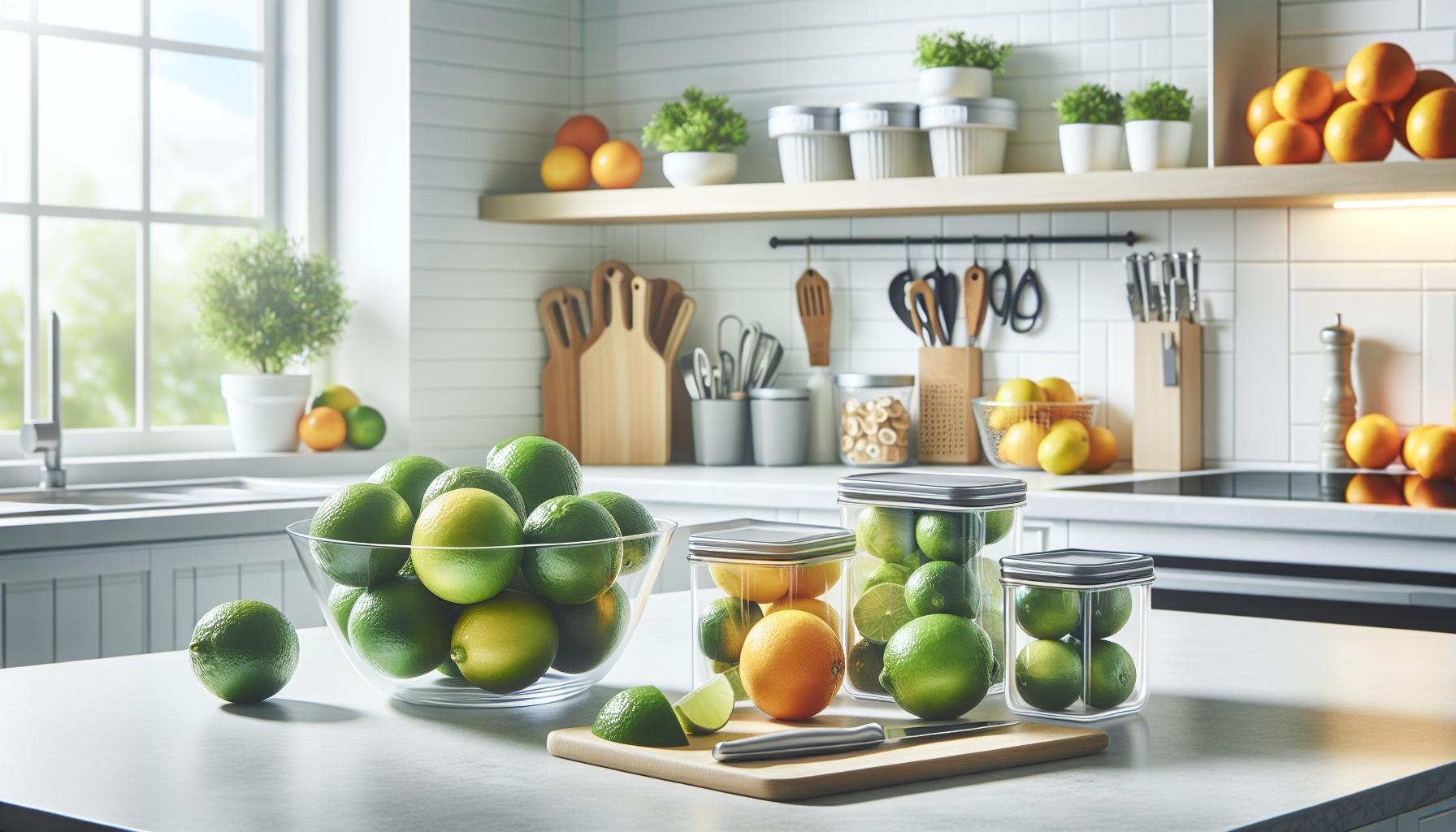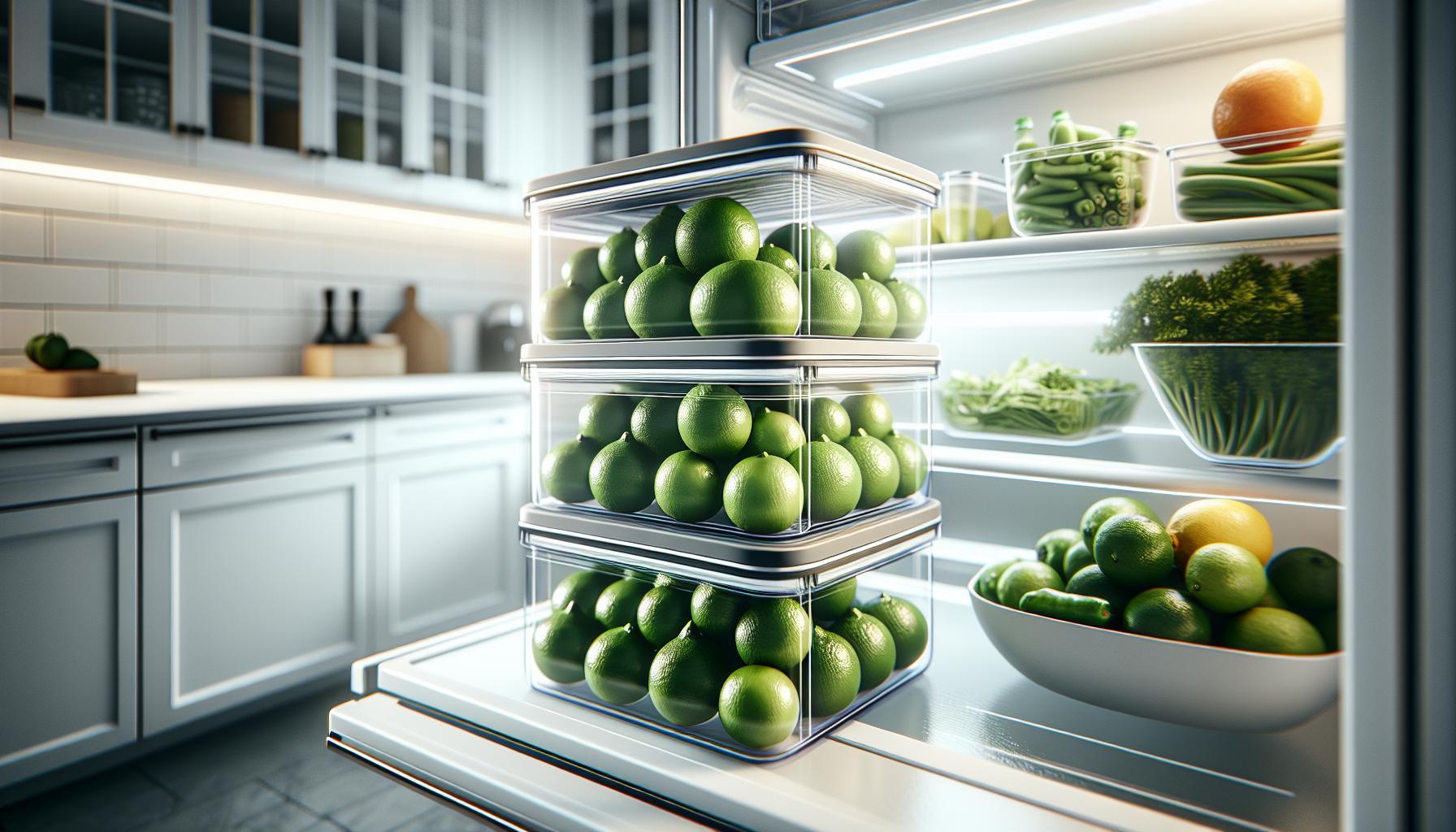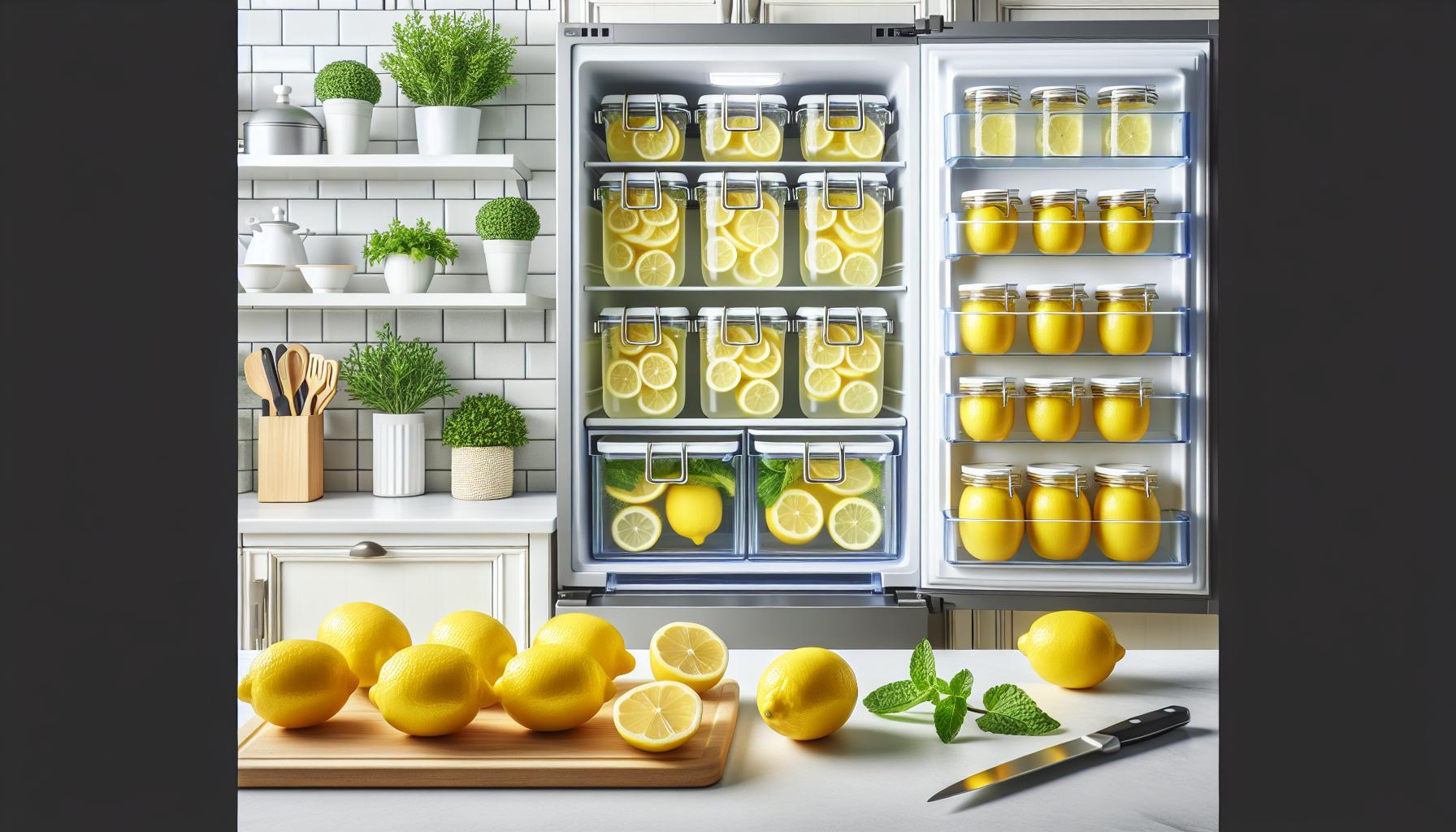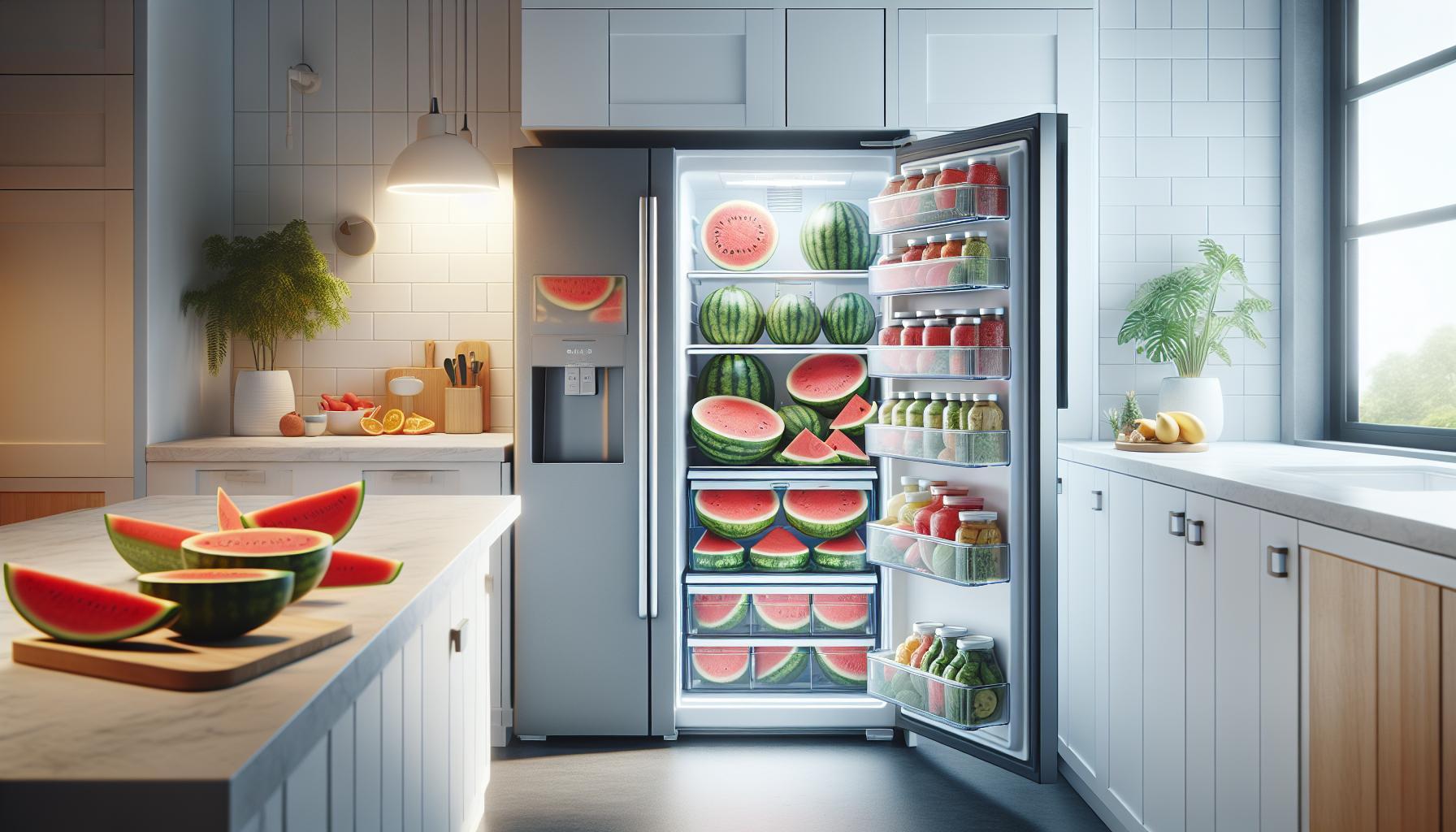Did you know that the vibrant lime can last up to a month in your fridge if stored properly? For many home cooks and cocktail enthusiasts, ensuring your citrus stays fresh is vital to enhancing flavors and minimizing waste. Understanding how long limes last not only helps you make the most of your grocery budget but also enriches your culinary creations.
In this article, we’ll explore practical storage tips and clear guidelines to help your limes maintain their zesty goodness for as long as possible. Whether you’re garnishing a drink or adding zest to a dish, knowing how to keep your limes fresh will ensure you always have this versatile fruit on hand. Dive in to discover how to best store your limes and extend their shelf life!
Choosing the Right Limes: How to Select Fresh Citrus

Choosing limes that are not only fresh but also flavorful can enhance your cooking and beverage experiences. When selecting limes, look for fruit that feels firm and heavy for its size; this generally indicates a higher juice content. The skin should be smooth and free from blemishes, wrinkles, or soft spots, which can be signs of overripeness or deterioration. Color can also give clues about freshness; a vibrant green hue is typically preferable, though yellowing limes can also be ripe and usable in certain recipes.
Another helpful tip is to give the lime a gentle squeeze. If it yields slightly without feeling mushy, it’s likely at its optimal ripeness. Additionally, a fresh lime should have a pleasant, zesty aroma at its stem end. Avoid any that have a dull smell, as this may indicate that they are past their prime.
To maximize your enjoyment, consider the intended use of the limes. If planning to use them for zests or garnishes, opt for the firmer, fresher limes. If you’re looking for juice, slightly softer, riper limes may yield more liquid. Remember that buying limes in bulk isn’t necessarily beneficial unless you have a plan for using or storing them effectively, as improper storage can lead to spoilage. Always prioritize selecting the right limes to ensure flavorful and fresh citrus at your table.
Ideal Storage Conditions for Limes in the Fridge

When it comes to preserving the fresh, zesty flavor of limes, understanding the ideal storage conditions in the fridge can make all the difference. The right environment not only helps maintain their quality but also extends their lifespan, allowing you to enjoy these vibrant fruits in various culinary applications. Here’s how to effectively store limes to keep them fresh for as long as possible.
First, it’s crucial to keep limes in a cool, dry environment. The refrigerator is the ideal spot, particularly in the crisper drawer, which is designed to maintain humidity levels optimal for fruits. Using a perforated plastic bag can help regulate moisture and air circulation, preventing the limes from drying out or becoming too wet. Make sure to avoid sealing them in an airtight container, as trapped moisture can lead to mold growth.
In terms of temperature, strive to maintain your refrigerator around 40°F (4°C). At this temperature, whole limes can remain fresh for up to three weeks. If you’ve already cut the lime, wrap the remaining half tightly in plastic wrap or place it in an airtight container to prevent it from drying out and absorbing odors from other foods. Cut limes should ideally be consumed within a few days to ensure peak freshness and flavor.
To maximize the shelf life of your limes, avoid storing them alongside ethylene-producing fruits, such as apples and bananas, as this can speed up ripening and spoilage. By creating a controlled environment for limes in your fridge, you can enjoy their bright, refreshing taste long after their purchase, enhancing your dishes and drinks with ease.
How Long Limes Stay Fresh: A Time Guide
Storing limes properly can significantly extend their freshness, making it essential to understand how long these vibrant fruits can stay good in the fridge. Whole limes, when stored at the optimal temperature of around 40°F (4°C), can last for about three weeks. This timeframe allows for the enjoyment of their bright, tangy flavor across various recipes, from drinks to marinades.
Once you’ve cut a lime, however, the timeline shifts considerably. Slices or halves should ideally be consumed within 3 to 4 days for the best taste and texture. After this period, they may start to dry out and lose their juiciness, impacting both flavor and culinary application. To keep cut limes fresher for longer, wrap them tightly in plastic wrap or store them in an airtight container, preventing exposure to air and external odors.
To illustrate the freshness timeline, here’s a quick reference:
| Type of Lime | Storage Duration |
|---|---|
| Whole Limes | Up to 3 weeks |
| Cut Limes | 3 to 4 days |
When storing limes, also be cautious about their neighbors in the fridge. Ethylene-producing fruits, like apples and bananas, can accelerate ripening and lead to quicker deterioration of your limes. By keeping your limes isolated, you can maximize their lifespan, allowing you to enjoy their zesty goodness for longer periods.
Signs That Your Limes Have Gone Bad
Limes are vibrant little fruits that can elevate dishes and drinks alike, but knowing when they’ve gone bad is key to preventing waste and ensuring food safety. As limes begin to deteriorate, subtle changes can indicate that they are no longer fit for consumption. Observing these signs can save you from an unpleasant culinary experience.
One of the first signs that limes have spoiled is their appearance. Fresh limes have a firm and smooth skin, typically a bright green hue. When they begin to go bad, you may notice the skin developing soft spots, wrinkles, or even mold, which can manifest as a fuzzy growth or discolored patches. If the lime feels mushy when squeezed, it is a clear indication that it has overripe and should be discarded.
In addition to physical signs, the aroma of a lime can also provide clues about its freshness. Fresh limes emit a zesty, tangy fragrance, while spoiled limes may have a sour or off smell. This olfactory hint often accompanies the other visual indicators, reinforcing the need for disposal. Another aspect to consider is the juice. If you cut a lime open and it appears dry or shriveled inside, the flavor will likely be lacking as well; you might be faced with a juice that tastes flat or overly bitter.
To keep your culinary endeavors free from spoiled fruits, it is essential to monitor your limes closely. Always check for these signs before use, and when in doubt, it’s better to err on the side of caution. Enjoying limes in their prime will not only enhance your dishes but also ensure you are consuming safe and fresh produce.
Best Practices for Long-Term Lime Storage
To ensure that limes retain their vibrancy and flavor for as long as possible, it’s crucial to follow best practices for their storage. Fresh limes can last about one to two weeks in the refrigerator, but with the right techniques, you can maximize their lifespan significantly, keeping them juicy and delicious for a longer period.
Start by choosing the right storage container. Placing limes in a mesh bag allows for airflow and prevents moisture retention, which can lead to mold. Alternatively, you can also store them in a crisper drawer, ideally in a plastic bag with small holes to facilitate ventilation. The relative humidity of the fridge is beneficial; just ensure the limes are not in the coldest part to avoid freezing, which can ruin their texture.
Maintain the optimal temperature for lime storage. Ideally, limes should be kept at temperatures between 40°F and 50°F (4°C to 10°C). Avoid washing them before storage, as excess moisture encourages spoilage. Instead, wash them just before use to preserve their integrity and freshness.
In addition to these guidelines, consider periodically checking the limes for any signs of spoilage. This includes monitoring their texture and appearance. If you notice any soft spots or signs of mold, use or discard those limes promptly to prevent them from affecting the others.
For those looking to keep limes for an extended period, freezing is an excellent option. Simply slice the limes into wedges or juice them, pour the juice into ice cube trays, and freeze. Once frozen, transfer the cubes to a resealable bag. This method not only saves space but also provides you with lime juice on demand for cooking or cocktails.
By following these practices, you can keep your limes fresh longer, enhancing your culinary creations and minimizing waste. Remember, a little attention to storage goes a long way in maintaining the quality of your limes!
Creative Ways to Use Overripe Limes
Overripe limes don’t have to go to waste; instead, they can be transformed into delicious and useful ingredients that elevate your culinary creations. When limes start to show signs of over-ripeness, their flavor can actually deepen, making them perfect for a variety of applications. Here are some innovative ways to give those overripe limes a second life while still enjoying their vibrant zest.
One of the simplest and most flavorful uses for overripe limes is to incorporate them into marinades. The natural acidity helps to tenderize meats, making it an excellent component for marinades for chicken, fish, or tofu. Combine lime juice with olive oil, garlic, herbs, and spices for a quick and delicious marinade. Additionally, overripe limes lend themselves well to salad dressings; just mix the juice with honey, mustard, and some olive oil for a zesty glaze that can perk up any salad.
Flavor Enhancer for Beverages
Don’t overlook the ability of overripe limes to enhance your beverages. You can use them to make refreshing limeade or add their juice to cocktails and mocktails. In a pitcher, combine the juice of the overripe limes with water and sugar to taste, stirring until dissolved. To give your drinks an even more aromatic twist, muddle them with fresh mint or basil before adding ice. Additionally, for those who enjoy baking, lime zest and juice can bring a delightful tartness to cupcakes, cheesecake, or even pancakes.
Preserving and Freezing
If you find yourself with an abundance of overripe limes, consider preserving their flavor. You can create lime-infused sugar or salt by mixing the zest with either ingredient and allowing it to dry. This mixture can then be used to rim cocktail glasses or as a seasoning for dishes. Another great option is to juice the limes and freeze the juice in ice cube trays. This not only prolongs the life of the lime juice but also provides you with conveniently portioned lime flavor to use in future recipes.
By thinking creatively about how to use overripe limes, you can reduce food waste and enhance your meals with their unique flavor profile. Whether in a marinade, as a drink mixer, or preserved for later use, those limes can contribute significantly to a range of culinary delights.
Freezing Limes: Step-by-Step Instructions
Freezing limes is a smart way to extend their shelf life and retain their vibrant flavor, ensuring you always have fresh lime juice or zest on hand for culinary creations. Whether you have an abundance of limes from a recent purchase or want to preserve them before they spoil, this process is both easy and effective.
To begin, wash the limes thoroughly under running water to remove any dirt or pesticides. Dry them with a clean cloth or paper towel. Next, you can choose how you want to freeze them: whole, juiced, or zested.
Freezing Whole Limes
If you prefer freezing whole limes, simply place them in a resealable plastic bag, trying to remove as much air as possible before sealing. This prevents freezer burn. Whole limes can be frozen for up to six months.
Freezing Lime Juice
For freezing lime juice, cut the limes in half and juice them using a hand juicer or an electric juicer. Pour the fresh juice into ice cube trays, filling each compartment approximately three-quarters full to allow for expansion as the juice freezes. Once frozen, transfer the lime juice cubes into a resealable plastic bag or an airtight container, labeling it with the date of freezing. Frozen lime juice can last for up to six months and is perfect for cocktails, marinades, and dressings.
Freezing Lime Zest
If you want to capture the zesty flavor of limes, zest them using a microplane or zester before juicing. Spread the zest out on a wax paper-lined baking sheet and freeze it for about an hour. Once frozen, transfer the zest to a small container or bag, sealing it tightly. Lime zest can also be frozen for up to six months, allowing you to add a burst of citrus flavor to your recipes any time.
Freezing limes, their juice, or zest not only reduces waste but also ensures you can enjoy their flavor long after their prime. This method supports optimal freshness, making this simple task a worthy addition to your kitchen practices.
Reviving Limes: Tips for Freshness Restoration
To keep your limes fresh and flavorful, it’s essential to know how to restore their vitality if they’ve begun to lose their firmness and zest. Limes are sensitive to environmental changes, and their quality can diminish quickly when not properly stored. Fortunately, there are several effective methods to breathe new life into your limes and make them suitable for use again.
One simple technique is to soak limes in warm water for about 10 to 15 minutes. This warm bath helps to rehydrate the fruit, plumping up the skin and restoring some of the juice lost due to dehydration. After the soak, gently pat them dry with a clean kitchen towel. This step not only helps revive limes but also prevents any excess moisture from promoting mold growth.
Another effective method for revitalization is to place your limes in a bowl filled with a mixture of water and a bit of vinegar. The acidity of vinegar can help eliminate mold and bacteria while also revitalizing the skin of the limes. After soaking for about 10 minutes, rinse the limes under running water to remove any vinegar residue and then dry them thoroughly. This method is particularly useful if you notice any slight wrinkling or texture changes in your limes, signaling that they need a quick revival.
For those limes that have become overly soft but aren’t yet spoiled, consider using them in recipes where texture is less critical. Juicing or zesting them is a great way to utilize these fruits before they go completely bad. Fresh zest can elevate dishes, and lemon-lime-infused beverages can still be refreshing depending on the ingredients used.
By employing these techniques to restore your limes, you not only reduce waste but also maximize your culinary options. Keeping limes fresh requires attention, but understanding these practical steps can ensure you enjoy their vibrant flavor for longer.
Health Benefits of Fresh Limes and Citrus
Fresh limes are not just a culinary delight; they are packed with a multitude of health benefits that can enhance your well-being. Rich in vitamin C, limes play a vital role in boosting the immune system, aiding your body in fighting off infections and diseases. Just one lime contains approximately 20% of the daily recommended intake of vitamin C, a powerful antioxidant that helps protect cells from oxidative stress and supports skin health.
In addition to their immune-boosting properties, limes can aid in digestion. The citric acid present in limes stimulates digestive enzymes, promoting better digestion and potentially alleviating bloating and heartburn. Consuming lime juice mixed with warm water before meals can make digestion smoother, while its high acidity may help to dislodge toxins and cleanse the digestive tract.
Another impressive advantage of limes is their potential to support heart health. The flavonoids found in limes have been linked to lower cholesterol levels and improved blood circulation. These compounds may also reduce the risk of cardiovascular diseases. Incorporating fresh limes into your diet-whether squeezed over salads, mixed into beverages, or used in marinades-can contribute positively to your heart health.
Moreover, limes are low in calories and high in dietary fiber, making them an excellent addition to weight management plans. Their tangy flavor can enhance the taste of many dishes, providing satisfaction and preventing the need for higher-calorie sauces and condiments. Utilizing lime juice in recipes can enhance flavors without adding significant calories, making it easier to maintain a healthy diet while enjoying vibrant flavors.
These benefits exemplify why maintaining freshness when storing limes is essential-not only for enhancing the flavor of your dishes but also for maximizing their health contributions.
Common Mistakes in Lime Storage to Avoid
Storing limes improperly can lead to premature spoilage, diminishing their vibrant flavor and health benefits. One of the most common mistakes is failing to refrigerate limes. While they can last at room temperature for a short period, keeping them in the fridge can significantly extend their freshness, often lasting up to three weeks when stored in a breathable produce bag or container. Not utilizing the right storage method can lead to moisture loss and degradation, making limes look wrinkled and unappetizing.
Another frequent error is leaving limes in plastic bags or containers that trap moisture. This environment can encourage mold growth and spoilage. Instead, consider using a mesh bag or perforated produce bag that allows airflow. Additionally, some people overlook the fact that cutting a lime can shorten its shelf life. Once cut, limes should be wrapped tightly in plastic wrap or stored in airtight containers in the fridge and consumed within a few days to ensure they remain fresh.
When it comes to fruits like limes, ethylene gas is another factor to consider. Many fruits, such as bananas or apples, emit this gas which can hasten the ripening process of limes. Placing limes near ethylene-producing fruits can lead to faster spoilage. It’s best to store limes separately to maintain their integrity.
Lastly, neglecting to check for spoilage before using limes is a common oversight. Always inspect your limes for signs of softness, dark spots, or unusual odors, as these are indicators of spoilage. By avoiding these mistakes, you can maximize the shelf life of your limes and enjoy their zesty flavor and health benefits for as long as possible.
Alternative Citrus Fruits and Their Storage
Citrus fruits are a delightful addition to any kitchen, offering vibrant flavors and numerous health benefits. However, their storage should be tailored to each type to maximize freshness and taste. Just like limes, other citrus fruits each have unique characteristics that influence how long they last and how best to store them.
Oranges
Oranges can stay fresh for up to two weeks when stored in the fridge, ideally in the produce drawer or a breathable container. To maintain their juiciness, avoid placing them in plastic bags, which trap moisture. Instead, keep them in a mesh bag or an open container that allows airflow. Room temperature storage can extend their lifespan to about a week, but the fridge is preferable for longer periods.
Lemons
Lemons, similar to limes, should be kept in the fridge to optimize their shelf life, typically lasting three to four weeks. To prevent moisture loss, wrap uncut lemons in a damp paper towel before placing them in a perforated plastic bag. Once cut, store the lemon halves or wedges wrapped tightly in plastic wrap or in an airtight container, where they should be consumed within four to five days.
Grapefruits
Grapefruits are best stored in the refrigerator, where they can last up to three weeks. Like other citrus fruits, they should be kept in a breathable bag or container to avoid moisture accumulation and subsequent mold growth. When purchasing grapefruits, look for firm fruit with smooth skin, as these are usually fresher and tastier.
Tangerines
Tangerines are more delicate than other citrus varieties and should be eaten within one week if kept at room temperature. For extended storage, place them in the refrigerator where they can last up to two weeks. Keep tangerines in a well-ventilated bag to maintain their freshness, ensuring to check them regularly for softness or signs of spoilage.
Each citrus fruit comes with unique flavor profiles and uses in cooking, so understanding their storage needs not only preserves their freshness but also enhances your culinary creations. By following these guidelines, you can enjoy the full benefits of each fruit, ensuring every bite is as vibrant as the last.
Maximizing Lime Lifespan: Expert Tips and Tricks
To keep your limes lasting longer and tasting fresh, understanding the right storage techniques is crucial. Limes stored properly in the refrigerator can last up to four weeks, while those kept at room temperature may only last about a week. The overall lifespan of your limes can be significantly extended with just a few simple practices.
First and foremost, always choose limes that are firm and free from blemishes. This ensures that you start with the freshest limes possible, which will last longer. Store your limes in the fridge in the crisper drawer, ideally in a perforated plastic bag. The perforations allow for airflow, reducing moisture buildup, which can lead to mold growth. If you prefer not to use a bag, a breathable container works as well.
If you need to cut your limes for use, wrap the unused portions tightly in plastic wrap or place them in an airtight container. This step prevents them from drying out and maintains their juicy flavor. It’s important to use the cut limes within about four to five days to ensure optimal freshness.
Additionally, if you find that your limes are starting to lose their zest, consider these quick revitalizing tips: immerse them in warm water for about 10 minutes. This can help restore some of their firmness and juiciness. Another engaging way to utilize overripe limes is to prepare a lime juice concentrate or zest the rinds to use in baking or cooking, which can add flavor without wasting any part of the fruit.
By following these expert storage tips, your limes can remain fresh longer, allowing you to fully enjoy their flavor and health benefits in your favorite recipes.
Frequently asked questions
Q: How do I know if my limes are still good to eat?
A: To determine if limes are still good, check for firmness, vibrant color, and lack of mold. If they feel soft, have dark spots, or are overly shriveled, they may be spoiled. Consuming fresh limes ensures the best flavor and nutrient content.
Q: What can I do with limes that are getting soft?
A: Use soft limes in cooking or drinks, as they may still have flavor. If they’re too soft or showing signs of decay, consider juicing them for use in dressings, marinades, or cocktails. This way, you can avoid waste while still enjoying their taste.
Q: Can I store limes in water to keep them fresh?
A: Storing limes in water is not recommended, as it can lead to mold and rapid spoilage. Instead, keep them in the fridge’s vegetable drawer, ideally in a produce bag. This method maintains moisture without making them soggy.
Q: Why do my limes turn brown after cutting?
A: Limes can turn brown due to oxidation after being cut. To minimize browning, sprinkle the exposed flesh with lemon juice, which contains citric acid, or cover them tightly with plastic wrap. This slows the oxidation process and keeps your limes looking fresh.
Q: How long do cut limes last in the fridge?
A: Cut limes can last in the fridge for about 3 to 5 days when stored in an airtight container. To maintain freshness, keep them wrapped tightly to limit air exposure, which can cause spoilage and dry out the fruit.
Q: Are there any special storage tips for limes?
A: Yes, store limes in the fridge at temperatures between 35°F to 50°F. Keeping them in a breathable bag can help regulate humidity, and placing them away from ethylene-producing fruits like apples can prevent premature ripening.
Q: Is it safe to eat limes that are slightly wrinkled?
A: Yes, slightly wrinkled limes are generally safe to eat, though they may have lost some juice and flavor. Use them in recipes where the lime’s flavor can still shine, such as in marinades or as zest in baked goods.
Q: What’s the best way to revive dried-out limes?
A: To revive slightly dried-out limes, soak them in warm water for about 10 minutes. This can help restore some moisture. After soaking, use immediately for cooking or juicing, as they won’t last long afterward.
Feel free to explore the other sections of our article for more detailed guidance on lime selection, storage, and usage!
The Conclusion
To keep your limes fresh and flavorful, remember that proper storage can extend their shelf life significantly. Following the guidelines shared can help you enjoy zesty lime flavors in your dishes for weeks, maximizing both taste and value. If you’re still wondering how to maintain other citrus fruits, don’t miss our articles on the longevity of lemons and oranges.
Feeling inspired to dive deeper into the world of fresh produce? Explore our meal prep tips or check out our food safety resources for practical advice. Your kitchen is a treasure trove of possibilities! Don’t forget to share your lime recipes in the comments below, and subscribe to our newsletter for the latest tips on food storage. Your journey to culinary excellence starts now-keep experimenting and enjoying every bite!





